Maria Goula is an architect with a Master’s in Landscape Architecture from ETSAB, UPC, Barcelona. She is also a unique personality in the field of Landscape Architecture Education. Maria has introduced and taught many students and professionals in landscape architecture. I have had the opportunity to be one of them and it is a great honour to present her in the out●siters interview series.
M.G. holds the position of Associate professor, Landscape Architecture Department, College of Agriculture and Life Sciences,CALS, Cornell University, since July 2014. She is also Adjunct researcher at the Institute Habitat-Tourism-Territory, iHTT, Polytechnic University of Catalonia, Sant Cugat del Valles, Barcelona and University of Malaga, Spain, since 2009.
Her academic carrier begun in Barcelona and continued there with her Doctorate (PhD) in Landscape Architecture Excellent cum laude (DUOT, ETSAB, UPC, 2007).
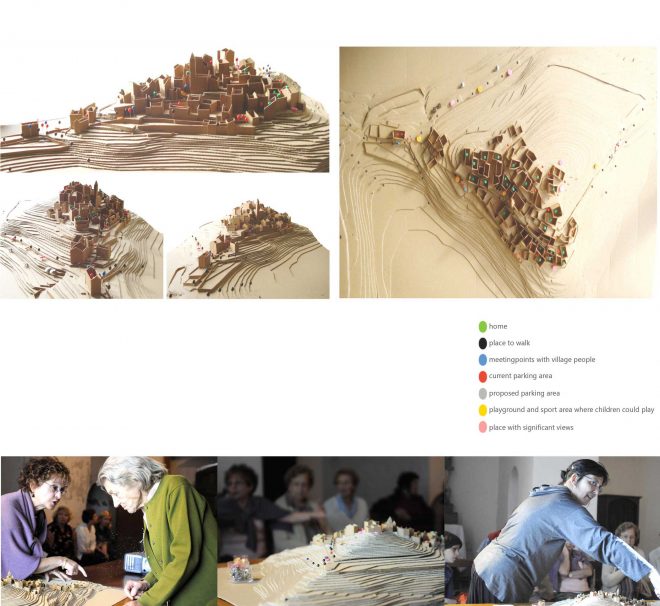
Maria works in the space in-between landscapes both as a teacher and as a professional. Her work on coastal, Mediterranean landscapes is constant and dynamic. Her research field focuses on what she has named “Second Coast” (Segunda Costa) and will be the subject of the book she is currently preparing with her associate Ricard Pie Ninot.
Maria’s research explores the interaction of man-made landscapes with water. The way we design and, eventually experience our coexistence with the marine element, as well as the alternatives and the strategies that would improve this interaction. Maria suggests that we took a step back and instead of comprehending the coastal line as rigid linearity, consider it differently. We should examine and understand the natural processes that create the coastal landscape like the river flow, the precipitation, erosion and accretion, even radical events like the floods and earthquakes. She thinks that this is the only way to take landscape design a step further, rather than diminishing it to a shallow arrangement of functions and green areas.
M.G. is concerned because the irrational and radical human intervention has led to”…hiding the water”. She thinks, and the recent flood and fire incidents point that out, that “…we keep losing the opportunities one after the other to understand and experience a fruitful, dynamic and creative coexistence with the water element.”
She also points out: “We think that natural processes concerning the water flow are disturbances, because we find ourselves unable to integrate them in the way we perceive and consequently design landscape.”
Going to the U.S.A. brought her in contact with a different type of landscape. Scale and design, compared to Europe, differ a lot on that side of the Atlantic. The vast surfaces form a different condition of the way humans work with the landscape. Post industrial areas are a new field of activity that demands professional attention. The Landscape Activists Movement, who tries to intervene where needed, without necessarily having the support of the State, is a new model of social empowerment. Such movements flourish thanks to the special society structure of North America, but also from the negligence of those in charge.
Maria was the team leader of one of the finalists in the International Architectural Competition «Re-imagine the New York State Canals» recently. She worked with her colleague at Cornell University, landscape architect Jamie Vanucchi and a selected team of professionals, such as Frank Talsma of H+N+S Landscape architects. The intervention area was the Upstate New York Erie Canal. The Team introduced an innovative approach for the areas along the Canal. The Proposal was named “UPSTATE ARCHIPELAGO” and it tackled the concept of the ephemeral flood as a generator of new landscapes. Allowing water to flow on a wider surface, means there would be less erosion from intense flood episodes and more efficient water management. At the same time there is enhancement of the biodiversity and new opportunities rise for tourism, water related athletic facilities and so on. There is evidently an important economic impact from the new activity in the area.
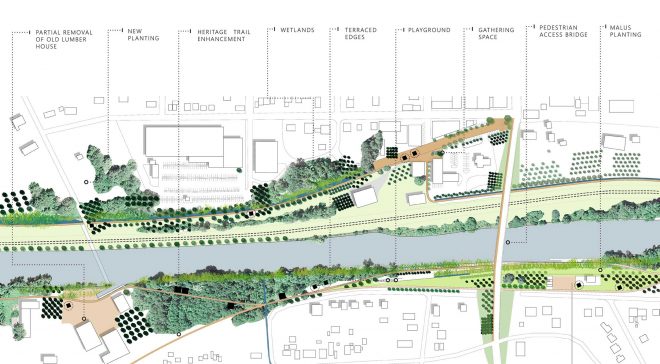
CLYDE WATERFRONT
MARIA GOULA,JAMIE VANUCCHI, FRANK TALSMA, (H+N+S LANDSCAPE ARCHITECTS), RICARD PIE NINOT, SANDI BASTEDO (WAYNE COUNTY CORNELL COOPERATIVE EXTENSION SOAR PROJECT COORDINATOR)
Maria started her studies in the Department of Architecture at the University of Thessaloniki. She first thought about specializing in landscape architecture urged by her father. Nevertheless, the person who played an important role in that was Rosa Barba. Maria stopped her PhD research in Urban Design to do a Master’s in Landscape Architecture, after her encounter with her. Rosa Barba was the first to understand that urban regeneration has little to do with working in a wider region, and argued strongly on that. Given the wide intervention Barcelona went through for the 1992 Olympic Games, the discussion on the subject and the new vision for the landscape were blooming and booming at the time. This new perspective became for Maria the turning point regarding her work as an Architect.
Maria dreams of designing a project on the variations of water as an element of landscape. Water becomes the catalyst not only in terms of landscape design but also on how buildings are formed.
Regarding Landscape Architecture in Greece, Maria believes that a Degree in University Level on Landscape Architecture should be established. She thinks that architecture and landscape architecture are related, though independent design fields, and they should be perceived as such both on an institutional and educational level. Especially, due to her involvement in the design of the first undergraduate program in LA in Barcelona and EMiLA, (European Masters in Landscape Architecture), she believes that there is room in the design schools for a discipline which defends public space and dynamic ecosystems.
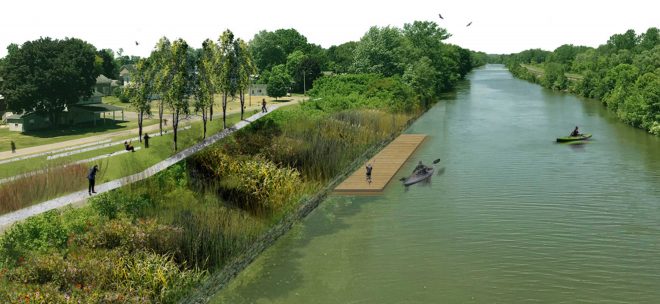
CLYDE WATERFRONT
MARIA GOULA,JAMIE VANUCCHI, FRANK TALSMA, (H+N+S LANDSCAPE ARCHITECTS), RICARD PIE NINOT, SANDI BASTEDO (WAYNE COUNTY CORNELL COOPERATIVE EXTENSION SOAR PROJECT COORDINATOR)
Asking her how new concepts and large scale projects could become reality, she answers with certainty:
“…architectural competitions will allow innovative ideas to emerge and offer the chance to young landscape professionals to present their work and potential.” Maria thinks that there is a new perspective towards that direction. She brings the example of topio7 in the architectural contest of Reconstruction and Reuse of former lignite mining areas in the region of Western Macedonia, and their proposal “Eco_corridor”
Maria Goula, beyond her constant research and her quest on new practices regarding landscape, is also an exciting teacher. Our rigid perception as architects evolved under her guidance and integrated the “…subtle, fragile expressions of landscape” as she was always repeating with emphasis. She also brought us in contact with other disciplines, like engineers, agronomists, biologists etc, and taught us to collaborate with them in order to reach a coherent result. As she pointed out in our discussion, on a sunny day in Barcelona, “…Landscape Architecture won’t make one a Star. It is a collective effort and a multidisciplinary process”.
After the workshop with Maria I cannot remember anyone of us being that tired and yet having evolved so much in working with the Landscape.
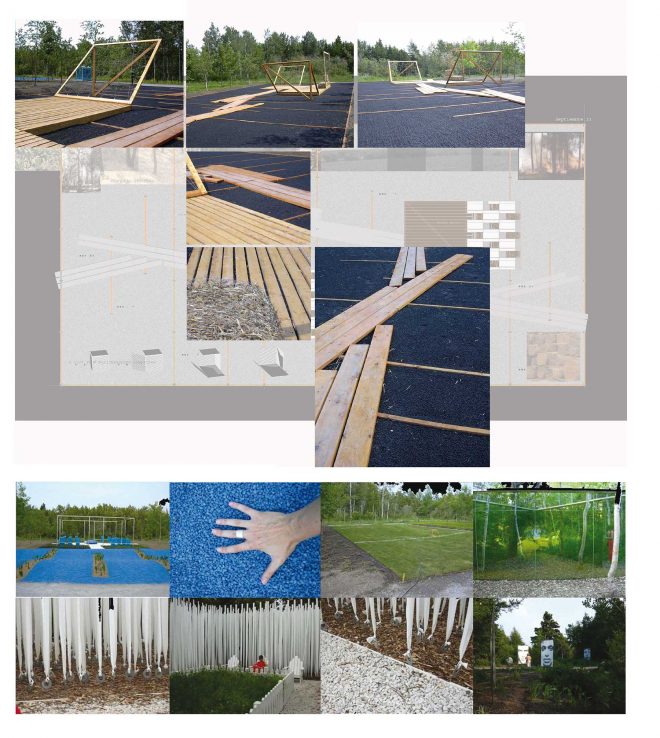
PRINCIPAL DESIGNERS: MARIA GOULA, ANNA ZAHONERO
Η Μαρία Γούλα είναι αρχιτέκτονας με μεταπτυχιακές σπουδές στην Αρχιτεκτονική τοπίου, στην Aρχιτεκτονική σχολή της Βαρκελώνης. [ETSAB, UPC] Είναι επίσης μια ξεχωριστή προσωπικότητα στο χώρο της εκπαίδευσης που ενέπνευσε και καθοδήγησε μια σειρά από φοιτητές και επαγγελματίες στον τομέα του σχεδιασμού τοπίου. Έχοντας υπάρξει μια από τους πολλούς μαθητές της, ειναι τιμή να τη φιλοξενώ στη στήλη out●siters.
Η Μ.Γ. κατέχει σήμερα τη θέση της Αναπληρώτριας Καθηγήτριας στο Cornell University στη Νέα Υόρκη (Associate professor, Landscape Architecture Department, College of Agriculture and Life Sciences, CALS, Cornell University,από το 2014). Παράλληλα είναι ερευνήτρια στο Institute Habitat-Tourism-Territory στη Βαρκελώνη (Adjunct researcher at the Institute Habitat-Tourism-Territory, iHTT, Polytechnic University of Catalonia, Sant Cugat del Valles, Barcelona and University of Malaga, Spain).
Η ακαδημαϊκή της πορεία στην Αρχ. Σχολή της Βαρκελώνης συνεχίστηκε με την εκπόνηση της διδακτορικής της διατριβής (Excellentcumlaude) με θέμα:
Η Μαρία εργάζεται στο μεταίχμιο των τόπων σαν αρχιτέκτονας αλλά και ως εκπαιδευτικός. Η ενασχόληση της με τα παράκτια, μεσογειακά τοπία είναι συστηματική και δυναμική.
Αντικείμενο και πεδίο της έρευνας της είναι αυτό που ονομάζει “Δεύτερη Ακτή”(Segunda Costa) και θα αποτελέσει το αντικείμενο του βιβλίου που εκδίδει με συνεργάτη τον Ricard Pie Ninot.
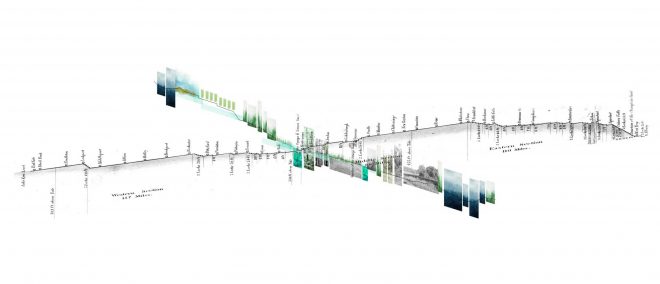
TERRITORIAL SECTION
MARIA GOULA,JAMIE VANUCCHI, FRANK TALSMA, (H+N+S LANDSCAPE ARCHITECTS), RICARD PIE NINOT, SANDI BASTEDO (WAYNE COUNTY CORNELL COOPERATIVE EXTENSION SOAR PROJECT COORDINATOR)
Η έρευνα της επικεντρώνεται στη διάδραση του ανθρωπογενούς περιβάλλοντος με το νερό, τον τρόπο που σχεδιάζουμε και τελικά βιώνουμε τη συνύπαρξη μας με το θαλάσσιο στοιχείο και στις εναλλακτικές στρατηγικές ώστε αυτή η σχέση να γίνει πιο γόνιμη. Η Μαρία προτείνει να πάμε ένα βήμα πριν την ακτογραμμή και να αντιληφθούμε τα φυσικά συστήματα που οδηγούν στη δημιουργία της, όπως είναι τα ποτάμια, οι βροχοπτώσεις ακόμα και οι σεισμικές δονήσεις. Θεωρεί ότι με αυτό τον τρόπο ο σχεδιασμός θα αποκτήσει πραγματική υπόσταση και βιωσιμότητα και δεν θα περιορίζεται σε μια επιφανειακή αναδιάταξη χρήσεων και χώρων πρασίνου.
Η Μ.Γ. προβληματίζεται επειδή η άλογη ανθρώπινη επέμβαση μας ώθησε να “…κρύψουμε τα νερά”. Θεωρεί, και τα πρόσφατα γεγονότα όπως οι πλημμύρες και οι πυρκαγιές τη δικαιώνουν,ότι “…χάνουμε τις ευκαιρίες την μια μετά την άλλη, να κατανοήσουμε και να βιώσουμε μια γόνιμη, δυναμική και δημιουργική συνύπαρξη με το στοιχείο του νερού.”
Η Μ.Γ. επισημαίνει «Αντιλαμβανόμαστε τις φυσικές διεργασίες των υδάτινων συστημάτων ως διαταραχή, γιατί δεν καταφέρνουμε να τις ενσωματώσουμε στον τρόπο με τον οποίο αντιλαμβανόμαστε και κατά συνέπεια σχεδιάζουμε το Τοπίο».
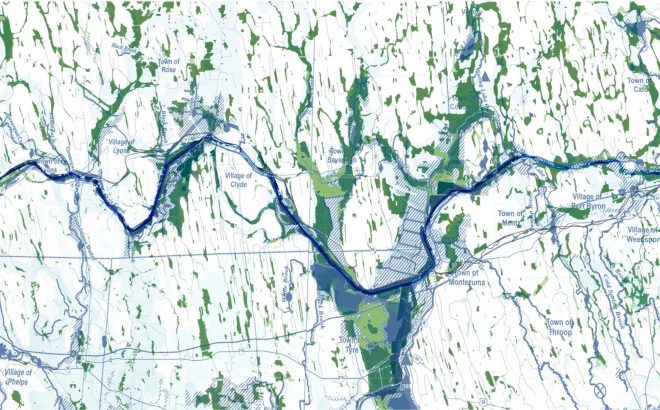
WET LANDSCAPES
MARIA GOULA,JAMIE VANUCCHI, FRANK TALSMA, (H+N+S LANDSCAPE ARCHITECTS), RICARD PIE NINOT, SANDI BASTEDO (WAYNE COUNTY CORNELL COOPERATIVE EXTENSION SOAR PROJECT COORDINATOR)
Η μετάβαση της στις Ηνωμένες Πολιτείες την έφερε σε επαφή με ένα τοπίο διαφορετικό σε επίπεδο κλίμακας και χειρισμού του χώρου. Oι αχανείς εκτάσεις δημιουργούν μια νέα σχέση του ανθρώπου με τον τόπο. Οι παλιές υποδομές και οι μετά-βιομηχανικές περιοχές (post industrial landscapes) αποτελούν ένα νέο πεδίο δραστηριότητας για την αρχιτεκτονική τοπίου.
H κίνηση των “landscape activists” που προσπαθούν να ξεκινήσουν νέες επεμβάσεις σε υποβαθμισμένες περιοχές, χωρίς να περιμένουν απαραίτητα την κρατική μέριμνα,αποτελεί ένα καινούργιο τρόπο κοινωνικής ενδυνάμωσης και υπαγορεύεται από το πολύ διαφορετικό κοινωνικό υπόβαθρο της Αμερικάνικης Ηπείρου σε σχέση με την Ευρώπη, αλλά και από την ιστορική έλλειψη κρατικού παρεμβατισμού ή μέριμνας.
Στον πρόσφατο διαγωνισμό «Re–imagine the New York State Canals» που συμμετείχε και διακρίθηκε, σε συνεργασία με την συνάδελφο της στο Cornell, αρχιτέκτονα τοπίου Jamie Vanucchi και μια επίλεκτη ομάδα συνεργατών με επικεφαλής τον Frank Talsma, από τους H+N+S Landscapearchitects, για την διαμόρφωση του Up state New York Canal,εισήγαγε μια καινοτόμα προσέγγιση στη διαμόρφωση των παρόχθιων επιφανειών. Η πρόταση της ομάδας της με το όνομα “UPSTATE ARCHIPELAGO” πρότεινε την περιπτωσιακή πλημμύρα στρατηγικών εκτάσεων με στόχο την δημιουργία μονίμων η και εφήμερων νησίδων. Δίνοντας περισσότερο χώρο στο νερό, μειώνεται η διάβρωση στα πρανή κατά μήκος των καναλιών, και ενισχύεται η λειτουργία τους ως μέρος του συστήματος προστασίας κατά των πλημμυρών στη Νέα Υόρκη. Αλλά ταυτόχρονα, με την δημιουργία υδροβιότοπων στα σημεία συχνής υπερχείλισης των καναλιών, αυξάνεται η βιοποικιλότητα και οι δυνατότητες για τουριστική χρήση, κωπηλασία, ψάρεμα κλπ. Προσφέροντας τη δυνατότητα για νέα οικονομική δραστηριότητα στην περιοχή.
Η Μ.Γ. ξεκίνησε τις σπουδές της στη Θεσσαλονίκη στο τμήμα Aρχιτεκτόνων της Πολυτεχνικής Σχολής Θεσσαλονίκης. Η ενασχόληση με το Τοπίο έγινε και με την παρότρυνση της οικογένειας της και ειδικότερα του πατέρα της. Ωστόσο ο άνθρωπος που όντως την οδήγησε στην Αρχιτεκτονική Τοπίου ήταν η Rosa Barba. Γνωρίζοντας τη, η Μ.Γ. άφησε το Διδακτορικό στον Αστικό Σχεδιασμό για να ασχοληθεί με το Μεταπτυχιακό της Αρχιτεκτονική Τοπίου. Η Rosa Barba διείδε πριν από όλους τη διαφορά της επέμβασης ανάμεσα στο αμιγώς αστικό περιβάλλον της Βαρκελώνης και τις περιοχές τις Περιφέρειας. Η συζήτηση για το χαρακτήρα τέτοιων επεμβάσεων ήταν πολύ επίκαιρη εκείνη την εποχή, λόγω της συνολικής ανάπλασης της Βαρκελώνης με αφορμή τους Ολυμπιακούς Αγώνες του 1992. Αυτό το νέο όραμα αποτέλεσε για τη Μαρία μια καμπή στη σχέση της με την Αρχιτεκτονική.
Το Έργο που ονειρεύεται να σχεδιάσει δε θα μπορούσε παρά να σχετίζεται με τις πολλαπλές εκφάνσεις του Νερού. Το Νερό, η παρουσία ή η απουσία του καθορίζουν συνολικά το σχεδιασμό του Χώρου, όπως τον οραματίζεται και αποτελεί καταλύτη της ευρύτερης διαμόρφωσης όχι μόνο στο επίπεδο του Τοπίου αλλά και στην αρχιτεκτονική των κελυφών.
Σχετικά με την Αρχιτεκτονική Τοπίου στην Ελλάδα,η Μαρία θεωρεί σημαντικό να γίνουν προγράμματα σπουδών αποκλειστικά για το Τοπίο, ώστε να υπάρξει η κατάρτιση και η εξειδίκευση που απαιτούν οι σύγχρονες συνθήκες. Πιστεύει πως η αρχιτεκτονική του κελύφους και η αρχιτεκτονική τοπίου είναι δύο σαφώς διαχωρισμένοι τομείς σχεδιασμού και αυτό πρέπει να γίνει αντιληπτό σε θεσμικό και εκπαιδευτικό επίπεδο.
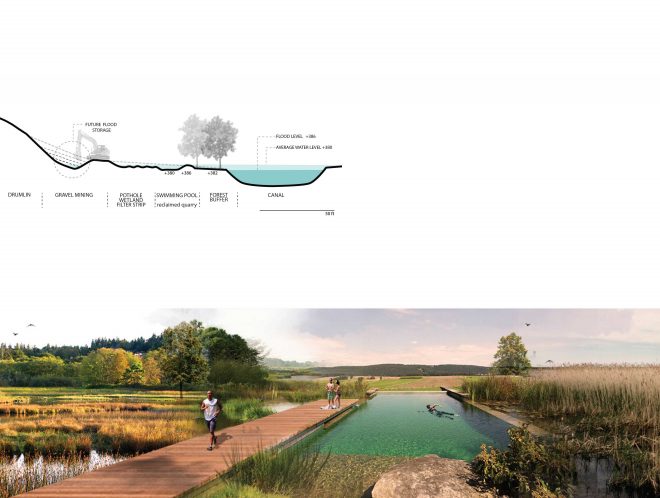
MINE EXCAVATION AS FLOOD MITIGATION
MARIA GOULA,JAMIE VANUCCHI, FRANK TALSMA, (H+N+S LANDSCAPE ARCHITECTS), RICARD PIE NINOT, SANDI BASTEDO (WAYNE COUNTY CORNELL COOPERATIVE EXTENSION SOAR PROJECT COORDINATOR)
Ρωτώντας την ποιο είναι το ιδανικό μέσο για την προώθηση νέων ιδεών και την υλοποίηση έργων μεγάλης κλίμακας απαντά με βεβαιότητα «…Οι Αρχιτεκτονικοί Διαγωνισμοί που θα φέρουν στην επιφάνεια φρέσκες ιδέες και θα δώσουν νέες ευκαιρίες σε αρχιτέκτονες τοπίου να παρουσιάσουν και να υλοποιήσουν τη δουλειά τους.» . Θεωρεί ότι προς αυτόν τον Τομέα έχουν γίνει ήδη σημαντικά βήματα και αναφέρει την πρόσφατη βράβευση της Ομάδας topio7 στον Διαγωνισμό «Ανάπλαση και Επανάχρηση πρώην εξορυκτικών περιοχών λιγνίτη στην Περιοχή της Δυτικής Μακεδονίας»με την πρόταση τους “Eco_corridor”.
Η Μ.Γ. πέρα από την αδιάκοπη έρευνα και αναζήτησή νέων πρακτικών σε σχέση με το τοπίο είναι μια συναρπαστική δασκάλα. Μέσα από το μάθημα της η στατική οπτική μας ως αρχιτέκτονες άρχισε να πλάθεται, να αλλάζει και να ενσωματώνει τις ” λεπτές, εύθραυστες εκφάνσεις του τοπίου” όπως επαναλάμβανε εμφατικά.
Επιπλέον, μας έφερε κοντά και μας βοήθησε να συνομιλήσουμε με άλλες ειδικότητες, γεωπόνους, βιολόγους και μηχανικούς ώστε να προσεγγίσουμε ολοκληρωμένα το αντικείμενο μας. Όπως σημείωσε χαρακτηριστικά κατά τη συζήτηση μας «…η Αρχιτεκτονική Τοπίου δε προσφέρεται για να γίνεις Star. Είναι ομαδική και πολυπαραγοντική εργασία». Μετά το Εργαστήριο της Μαρίας δεν θυμάμαι να είχαμε κουραστεί πιο πολύ αλλά και εξελιχθεί πιο πολύ στο Σχεδιασμό του Τοπίου.
READ ALSO: VyTA Covent Garden in London by COLLIDANIELARCHITETTO combines the warmth of Italian hospitality and contemporary taste